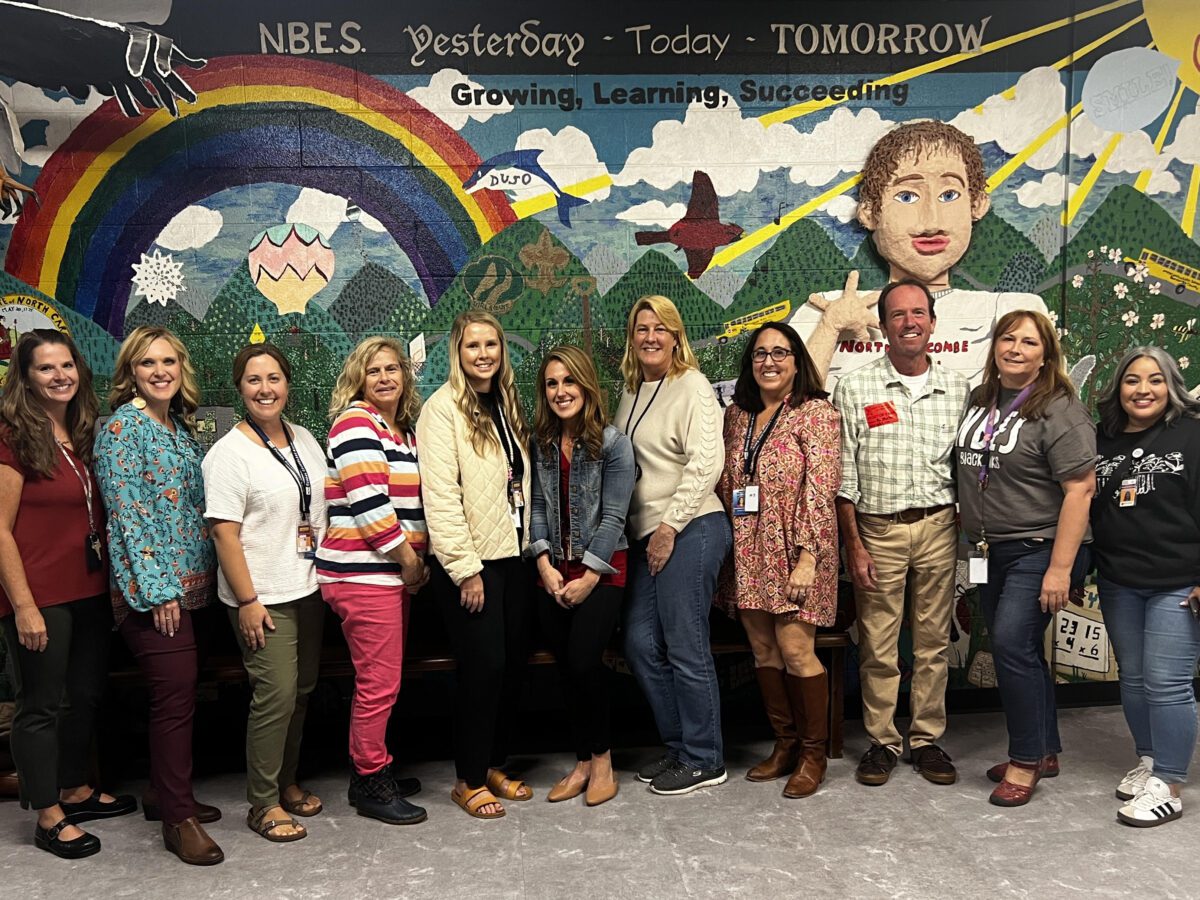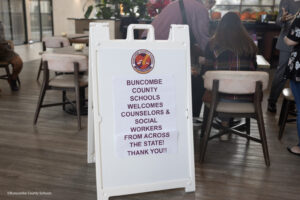Together We Rise:
From The Mountains To The Coast, School Districts Join Together To Support Our Return To School
By Dr. Rob Jackson, Superintendent of Buncombe County Schools, EdNC
Fifty-three school districts sent 263 school counselors and social workers to support the return of students and educators in Buncombe County after Hurricane Helene

On Sept. 27, 2024, Tropical Storm Helene arrived in western North Carolina. After days of heavy rains, the downpour resulting from Helene’s arrival caused valleys to fill with water as rivers and creeks rose to their highest recorded levels and mudslides consumed much in their path as they gathered speed down mountains known more for their beauty than their danger.
The former Category Four Hurricane still packed enough punch to cause an estimated $53 million in damage in North Carolina according to Gov. Roy Cooper in his Oct. 23, 2024 letter to the state’s General Assembly.
The North Carolina Department of Health and Human Services reported 99 verified storm-related deaths as of Oct. 29, 2024, with 43 of those in Buncombe County alone. Buncombe County Schools lost four students following the storm.
In the immediate aftermath of the storm, with no power, no water, no internet, and no cell service, Buncombe County felt completely isolated from the rest of the world. Damage to Interstate 40 to the east and west of Asheville and to Interstate 26 to the north and south, as well as severe damage to roadways, missing bridges, and downed trees made this feeling more reality than initially supposed.
The school district had been called upon to evacuate survivors during the storm using school buses. In the hours and days and weeks that followed, school personnel would provide food for the shelters, transportation to medical appointments for those living in shelters, fuel for emergency responders and law enforcement, sleep sites for responders, distribution sites for critically needed provisions, and work locations for FEMA.
Each time I heard my name called out was followed by a request: “Dr. Jackson, can the school district…”, the response was always the same, “We will find a way,” whether the person asking was the sheriff, the county manager, the fire marshal, the emergency management director, the local FEMA representative, or a nonprofit leader who needed space to serve the community.
“We will find a way.”
Dr. Rob Jackson
We saw neighbors helping neighbors and heroic efforts from search-and-rescue, law enforcement, and first responder personnel. District team members jumped in to help anywhere there was a need. Help for the community arrived from across the state and beyond.
As the days passed, questions were raised about when schools might be able to reopen. Most of the 45 schools in our school district remained without power, water, and internet connectivity, but slowly those numbers began to move in a positive direction. Repairs were underway in schools impacted by flooding or roof leaks. The 15,000+ miles traveled each day by our school buses were being remapped to detour around missing bridges and damaged roads with community stops being implemented where buses could no longer travel.
The final physical challenge, lack of water, looked to be insurmountable, but educators don’t believe in impossible and no less than three separate solution scenarios were being worked on simultaneously. Finally, non-potable water began to flow through the pipes and our school district took on the challenge of delivering four bottles of water per day for each student and staff member in each of the county schools, each of the schools in the Asheville City School district, and in seven charter schools, totaling approximately 110,000 bottles of water per day.
Beyond the physical challenges, perhaps the most important of needs loomed: the need to support the mental health and well-being of students and staff who had all lived through the trauma caused by what has been called the greatest natural disaster in the history of the county. The school district had a robust crisis response plan, created in 2007 and continually revised. When a tragedy occurred within a school community, school counselors and school social workers from across the school district would respond to the impacted school to be present for students and staff who needed someone to talk to.
This was different. All 45 schools were significantly impacted. Students and staff members had lost family members, had lost homes, had lost cars, had significant damage to their property, lived in neighborhoods that were no longer there, or simply lost the sense of safety and security. Tears were frequent throughout the community and words to describe feelings were hard to come by. There would simply not be enough school counselors and school social workers in the school district to support everyone on the first few days back.
The need to support hurting students and teammates kept me from sleeping. It was sleep that would not come that led me to find myself running down the roadside in the middle of the night with the light from my headlamp, bouncing along the debris that was strewn on both sides of the road. I found myself considering all of the emails and messages I had received from superintendents and principals from across the state offering their help, but not sure what was needed.
In a moment of clarity, need met possibility on a roadside late at night.
Our school districts needed more school counselors and school social workers — and school districts wanted to help. I began to compose an email in my head as I continued to run. Back in my house with a candle sitting next to my computer, I began to type out the need and the request. I realized that before sending it, I would need to do two things: 1) email the superintendents in each of the school districts impacted by the storm to see if they had similar needs so that we could consider a joint request, and 2) ask some fellow superintendents across the state to review the draft email to think through the request with me.
At the time, no other school district had a need for “borrowed” personnel and with a few revisions made after thinking with others, I emailed the other 114 school superintendents across the state to ask if they would consider inquiring among their staff for school counselors and school social workers who might volunteer to travel to Asheville to be present for a day with staff who might want to talk with someone and to help plan for the first day back for students and to be present as we reopened our schools to our 22,000+ students.
The generous response was immediate and massive: 53 school districts were able to participate and sent 263 school counselors and school social workers to assist our students and teachers upon their return to school.
These incredible educators made a profound difference. Thanks to an anonymous donor who covered the travel expenses for those who needed it, we were able to house them in three locations. Each evening, my wife Rene and I visited with them in hotel lobbies, armed with batches of fresh-baked cookies to share our appreciation. In every single case, we were stopped in saying thank you as the school counselors and school social workers from across the state shared their appreciation for the opportunity to help.
 Imagine the hearts of these volunteer, visiting professionals who were more interested in expressing their gratitude for the opportunity to serve than in being thanked for the gift of their time and expertise.
Imagine the hearts of these volunteer, visiting professionals who were more interested in expressing their gratitude for the opportunity to serve than in being thanked for the gift of their time and expertise.
I would like to share a special thank you to the following 53 school districts from across the state who generously responded to our request for help and sent staff to support our students and teammates during our time of reopening schools in the wake of Hurricane Helene: Alamance-Burlington, Brunswick County, Burke County, Cabarrus County, Caldwell County, Carteret County, Catawba County, Cherokee Central Schools, Cherokee County, Clay County, Cleveland County, Columbus County, Cumberland County, Davidson County, Davie County, Edenton-Chowan, Elkin City, Gaston County, Graham County, Harnett County, Henderson County, Hickory City, Hoke County, Iredell-Statesville, Jackson County, Kannapolis City, Lee County, Macon County, Martin County, Montgomery County, Moore County, Mooresville Graded Schools, Mount Airy City Schools, Newton-Conover City Schools, Pender County, Pitt County, Randolph County, Richmond County, Robeson County, Rockingham County, Rowan Salisbury Schools, Rutherford County, Sampson County, Scotland County, Stanly County, Stokes County, Surry County, Union County, Vance County, Wilkes County, Wilson County, Winston-Salem/Forsyth County, and Yadkin County.
Additional school counselors and school social workers from across the state will be assisting in the coming weeks in the schools with the greatest needs.
The collaborative spirit and unity demonstrated by school districts across our state, from the mountains to the coast, highlight the strength of our public schools. Together, they have shown that we are more than just individual districts; we are a family dedicated to the welfare and success of our students throughout the state. The support they offered has reinforced the importance of solidarity in the face of adversity. Our school district’s theme this year, #TogetherWeRise, was introduced at convocation in August. Over the course of the month of October, the truth and power of this statement has never been more evident. From north to south, from east to west, all across our great state, even in the greatest of tragedies, still, together we rise!
“We are a family dedicated to the welfare and success of our students throughout the state.”
Dr. Rob Jackson
I am hopeful that all who joined us were able to return and share their experiences, giving the opportunity for their school districts to review their own crisis management plans for approaching a natural disaster. I am also hopeful that should another school district find itself with a need to borrow staff members in the event that an emergency happens, that we have the opportunity to pay forward the incredible gift that we have received.
We are beyond grateful for the kindness and generosity shown to our students and teammates. We are deeply appreciative of the commitment shown by school districts across the state to ensuring that all students and staff receive the support they need during this recovery process. We are also extremely grateful for all who have donated water and supplies for school districts throughout western North Carolina.
More than ever, I am proud to be an educator. We teach our youngest learners to look for the helpers in times of trouble. In Buncombe County Schools, we looked for the helpers, and from across North Carolina, they arrived right on time with their hearts and hands open.